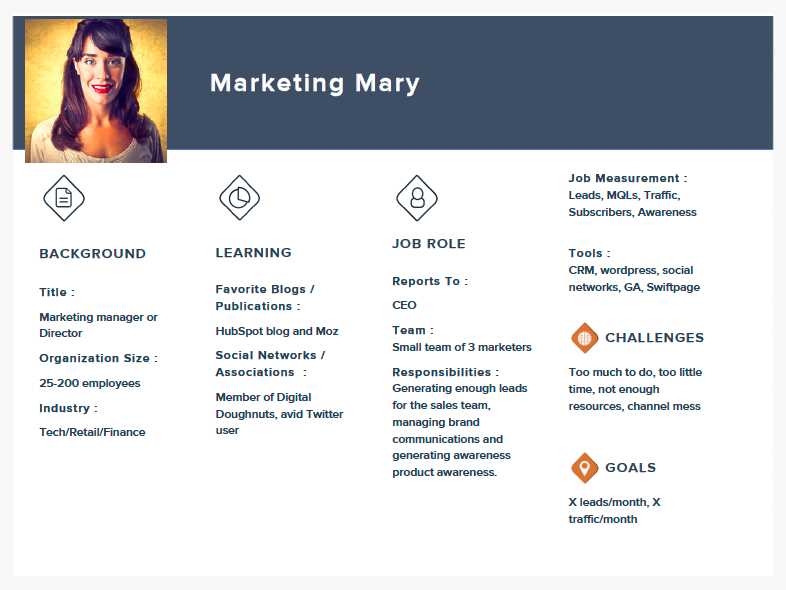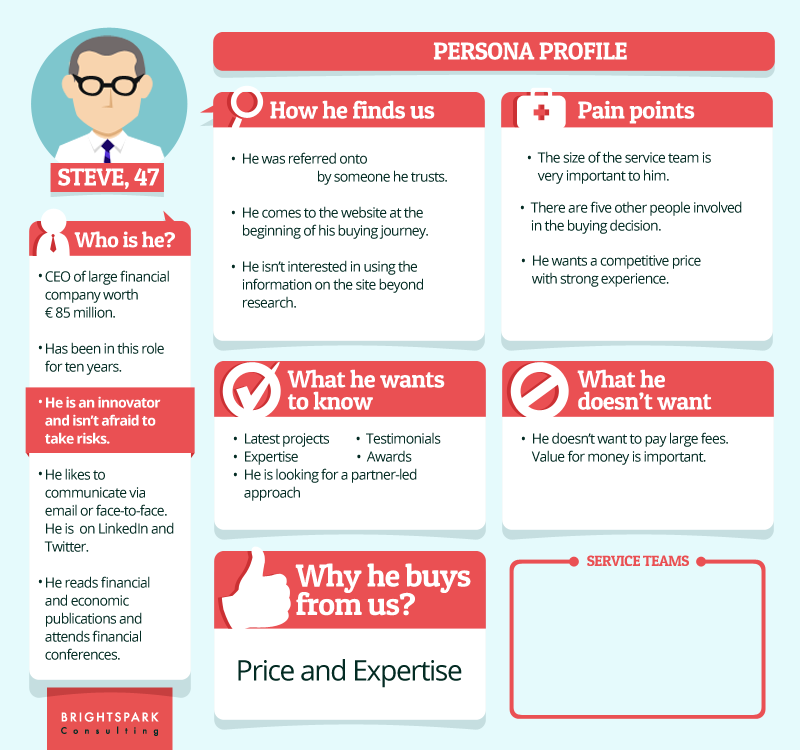+353 86 3577540
|
I had an interview once for a content marketing role and the interviewer asked me what would be the first thing I would do if I got the job. My answer? Analyse the customer personas and compare them to the current content being produced to see how closely they aligned.
“Customer personas...right...ok...”, the interviewer mumbled in reply while his face remained blank and he went slightly pale. And then an eerie silence fell for a few seconds and I imagined tumbleweed and dust rolling past my feet. And in that moment, everything made sense. I had combed through all of their content in the days leading up to the interview and I just couldn’t figure out who their main customer personas were. There was a lot of content, yes, but it was sheer volume over quality and relevance. No wonder their content was a random mix of odd articles, beautiful infographics that had no relevance and poor case studies, I thought, when the head of the team didn't know what customer personas were. But more than that I couldn’t shake the feeling they had created a blog because that’s what their competitors did and now they didn’t know what to do with it and some poor Marketing Executive was tasked with writing blogs just to have something up there. Sound familiar? Nowadays, I often think of that interview whenever I meet new clients or am just chatting at a networking event. Inevitably, the “content marketing” topic comes up and 99 times out of 100 the response will be something along these lines: Them: “Content marketing? I tried that for a while. It’s so time consuming, I actually hate writing, it doesn’t work and and it’s a total waste of time. And it’s impossible to measure the ROI. No. Not for me!” Me: “Hmm, well maybe you might need to look at your customer personas. When was the last time you updated them?” They stare blankly back at me (just like that interviewer) and then the silence falls between us for a few seconds. And then I give them a list of things to do to create customer personas. What are customer personas and why do I need them? Customer personas are not complex, deep, psychoanalytical profiles. Instead, they are generalistions of your 3-4 top customer segments that not allow you to write better, targeted content that will be interesting and of use to your customers, but they are also essential for your sales, marketing and product teams. Customer personas are just a list of traits, characteristics, motivations and behaviours of the main groups of people who use your products or services. You give these anonymous a name and a face. And then every bit of content that you even think about writing must be of value to one or all of these customer personas. It’s like lane assist on your sat nav - it keeps on track and alerts you if you veer off to the left or the right. What do customer personas look like? There are different versions of customer personas floating around - some are basic and some more advanced and delve in quite deep. I like the one below as it covers the basics but you can add a bit more to it if you want.
1. What information do you need?
For now, start with the basics. The following criteria will get your started:
2. Talk to your Customer Service and Sales teams Once you have your list of criteria drawn up, you then have to go and get this information. But before you start putting together surveys or calling customers, arrange a chat with your customer service team first and your sales team second. If you work for yourself, then arrange a chat with yourself! Your customer service team are a mine of information and they know all of the customer personas without even realising it. Start by interviewing one customer service agent (if you have a dictaphone bring that along so that you listen carefully without having to take notes.) As you go through your list of criteria, you will see that there could be at least 3-4 various personas and sometimes even more. Don’t worry about that at this stage. Just sit, listen and work through the list. Repeat this with someone from your sales team. But bear in mind that the sales team are dealing with customers further up the sales funnel, and don’t be thrown if they give you other information and perspectives than the customer service team. Let it all just mull around in your head. 3. Talk to your customers Now that you have a good idea of the various types of customer personas, it’s time to contact your customers directly. There are the usual various options here and you can do all of them or just the one.
Just like the chat you had with customer support and sales, you are there to listen and to guide the conversation. There are no definite outcomes at this stage. However, you might have some gaps in your knowledge that neither sales or customer service could answer for you. This is the perfect opportunity to go after that information. 4. Analysis This is the easy part would you believe as it practically writes itself. In the background, your brain has been quietly filtering and distilling all of the data. Common trends, patterns and themes will emerge naturally. And guess what - you probably had a good idea of most of your personas already but lacked specifics. Start putting your thoughts down on paper. Offload all of that information onto a page. Don’t worry about structuring it all yet, that part comes later on. At this stage, I have no doubt that you will begin to see differences in the kind of language / phrases / buzzwords / acronyms used by various personas and differences in what they like to read, how they work, their daily routine, challenges and goals. This is also an interesting stage for you as a content writer. You will find yourself starting to come up with many, many, many new ideas for content, but you will also start getting clarity on why your previous pieces might not have been as well received as you would have liked. 5. Name your customer personas and add in a picture Now you are ready to name your customer personas and give them a face to bring them to life. There is a very common pattern for names of the personas - SEO Sam, Marketing Mary, CEO Colin, Managing Director Monica - the first letter of the role is the first letter of the name. It helps to make the names easier to remember but also cements their role / function and serves as a constant reminder of how they use your product or service. 6. Who is your primary customer persona? By now, you will have a good idea of the total number of customer personas that are relevant for your business. However, it is up to you to decide if all of your customer personas are equal or if there is one stand out customer and a few secondary customers. If you only have one customer persona you might be keeping things a bit narrow. But if you have 20+ customer personas it might be time to focus on your top 5 for now and come back to the rest of them later on. 7. Curate the information Next, it’s time to look at editing all of that information from Step 4. Essentially we want a minimal, refined profile with only the core information. But the first thing I do is make a copy of the original document and leave this intact. Now, it’s time to slash and burn excess information in what will be your working copy. If you are finding this difficult and don’t want to remove anything because you think everything is relevant, just think of what information would be relevant to absolutely every individual in your organistion. If, in a few days, you feel that you might have over edited, go back to the original profile and add in whatever you feel is relevant. 8. Design If you have a graphic designer in your team or work with a freelancer, kindly put in a design brief to turn your work into something visually appealing. There are loads of examples online but I love this one in particular from Brightspark consulting. 9. Circulate What’s worst than not having customer personas at all? It would be going through all of the steps above and then leaving your perfect personas sitting on a computer file never to be used by anyone else in the organisation. Hold a presentation and communicate why the personas are so important and how they are used by the content marketing team, but also how they are essential for everyone else in the organisation. HR can use them for new staff inductions to show new people who the customers are. The receptionist can use them for meeting and greeting clients. The product development team can use them to truly understand the motivations, behaviours and day to day realities of the people who are using the product. 10. Constantly review and update Well done on creating your customer personas! A big pat on the back, and enjoy that well deserved champagne. But…don’t let your customer personas get out of date. Ask your sales and customer service team to let you know if they think that they have found a new persona or if they think the current personas need to be updated with new information. So there you have it - 10 steps for creating your first customer personas. Once you have your personas, you’ll be amazed at the difference they will bring to your content. All of a sudden, your topics and themes will become more relevant and engagement increases. You’ll begin to see a rise in comments and shares. And it all starts with truly understanding all of the people who are your customers. Good luck! Your comment will be posted after it is approved.
Leave a Reply. |




 RSS Feed
RSS Feed


21/9/2017
0 Comments